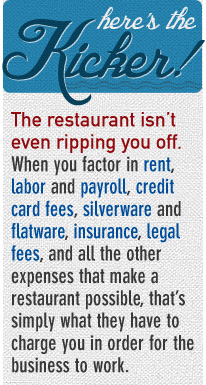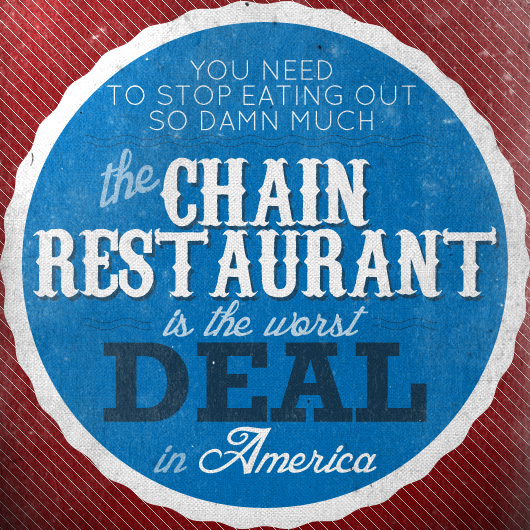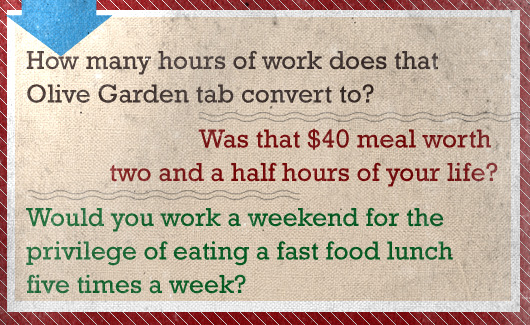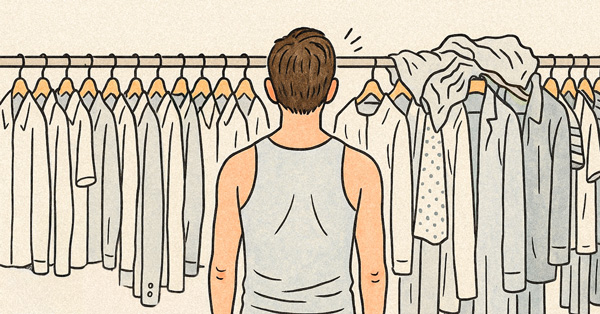The rise of the sit-down, mid-priced chain restaurant happened too long ago for most Primer readers to take notice. But in the grander history of human eating, it’s a relatively newfangled trend. Before the American diet got balled by the chain, eating out was either a necessity for travelers or a luxury for revelers. It wasn’t meant to be affordable (or healthy) for the everyday Joe to take himself and maybe his wife and kids there two or three times a week. The industry took a look at that gap between truckers and rich people and saw an untapped market. And for the past few decades, they’ve been trying to convince us that our bank accounts and bodies can afford to sit down at a restaurant three or four or five days out of the week for breakfast, lunch, dinner or all three.
But anyone who balances their budget or steps on the scale with any degree of conscientiousness knows that this isn’t true. A lifestyle of habitual eating out shares the same space in the American Dream as the subprime mortgage, the 9 mile to the gallon sport utility vehicle, and the credit card cash advance. It’s a rotten deal and it will lead to your financial, physical, and emotional downfall.
Okay, not really, but eating out at chain restaurants is certainly among the biggest money wasting opportunities available in the 21st century. Most of us know that on some level, yet we still do it. Why? We’ll get to that later. For now, let’s talk about why you seriously need to stop eating out so much.
Restaurant Markup
The markup between what a restaurateur pays for food and what you pay for food is astonishing.
Some highlights from a deconstruction of restaurant markups by SFGate.com:
- Fountain drinks – 2,000% markup
- Canned soda – 800% markup
- Wine by the glass – 300% to 400% markup
- Pasta dishes – 600% to 1,000% markup
- Mixed green salad – 800% markup
- Eggs – 500% markup

Really, though, you don’t have to approach it like an MBA. Just think about what you’d pay for the same food or drink in a supermarket. One Coke (actually, is Pepsi okay?) costs $2 or more with your meal, which is more expensive than an entire 2-liter bottle from the store. And you don’t have to tip anyone at the supermarket.
Just about everything on your plate at a restaurant stacks up the same way compared to buying it off the shelf or from the meat counter. One family dinner at a sit-down chain probably costs as much as the entire week’s grocery bill for the household.
That’s a high price to pay for such a fleeting pleasure (assuming it’s pleasurable at all–see below).
Calories, Fat, and Other Bad Stuff
Fast food is the poster child for gut-busting, artery-clogging, empty calories. But sit-down joints are even worse offenders. For example, the Margarita Grilled Chicken from Chili’s weighs in at 550 calories, which is exactly 10 more calories than a Big Mac. And that’s from the “Lighter Choices” menu. For items beyond the confines of the Weight Watchers inset on the menu, restaurants adopt the philosophy that “there’s no such thing as too much butter.” The amount of salt, butter, oil, and sugar a restaurant puts in its food is exponentially higher than what a sane person would put into their home cooking. And that’s the real secret sauce.
Couple that with the fact that most diners feel cheated if they receive anything lesser than a portion fit for a gorilla and it’s no surprise that more than a few meals on the Chili’s, Applebee’s, Olive Garden, and Ruby Tuesday menus break the 2,000 calorie threshold. If you’re getting an appetizer (which are the worst in terms of fat, carbs, and calories) and free refills on your soda, then you’re in even worse shape.
So, next time you’re calculating the cost of eating out for a month, make sure you factor in the gym membership as well.
Lowest Common De-omnomnom-nominator
The most unsavory thing about those ubiquitous chain restaurants is that we don’t even really enjoy them. So why do we end up there all the time? The truth isn’t all that hard to swallow. Your Applebees and Tchotchkes are the sit-down restaurant equivalent to the emotionally abusive on-again off-again significant other you keep winding up with against your better judgment. It’s the place you end up whenever you get too tired to think of something better. It’s discomfort food with a side of resignation.
Like that haplessly tenuous relationship, our destructive addiction to the chain defies logic but still manages to tap into something more primal. It’s like we’re subconsciously pulled there, even though we’re going to have buyer’s remorse about 12 seconds after placing our order. There’s an explanation for that.
First is the bit that we already covered about the fats, salts, MSG, and other gastronomic shortcuts. These are cheap tricks that pander to your tastebuds like an arena rocker working your hometown into the third verse. They trigger a vestigial reward response in your brain that was useful to prehistoric man, back when calories were sparse. But for modern man, this innate hankering for fat only serves to make us disgusting. That doesn’t stop chain restaurants from riding that one-hit wonder all the way to the cardiac ward, though. The fact that we are hard-wired for fat and salt is exploited just as aggressively by sit-down chains as fast food dives.
The second prehistoric mind trick is a variation on that theme. Like rats in a maze, our brains tend to “bookmark” the circumstances that lead to a fat-rich meal. That’s why it’s so easy to get hooked on a particular restaurant. Branding and psychology converge to drag you into that familiar setting again and again. Ruby Tuesday isn’t just compensating for something by erecting mile high signage along the freeway–they are trying to reach into your normal life and trigger your cravings. (There’s a post-modern literature professor somewhere out there that would love to help you examine the implications of a chain restaurant that feels like home away from home, no matter where you are. But the restaurant tycoons already figured it out: it means fat profits.)
That familiarity formula works particularly well with groups, especially when the constituents aren’t very well-acquainted (e.g. work functions, job interviews, cheap first dates). Chain restaurants are always a safe bet. It’s not so much that everyone likes the chain, it’s more that we all have the same low expectations. Patronizing soulless, predictable chains has practically become etiquette. In fact, that’s how many of us get our first taste, and subsequently get hooked–peer pressure.
The other great thing about chain restaurants is that, unlike cooking at home or taking a risk on a no-name mom-and-pop eatery, if something does go wrong, you don’t have to take the blame. There’s an unwritten contract between chain restaurants and their patrons: every time you eat in one of our restaurants, your experience will be exactly the same as the last time you ate at one. It doesn’t matter if it’s a weekend or weekday or if you’re in Chicago or Tucson, every restaurant with a TGIFriday’s sign above it will come with precisely no surprises. As we all know, though, that contract is routinely broken, be it by a surly waitress, a fire in the kitchen, or a one-in-a-million screw up. Everyone in your party will agree that it was an awful time because of that, but at least you, the Chooser of the Restaurant, will not get heat for it.
Whether alone or in a group, chain restaurants are where we flee when we are feeling stressed, indecisive, or lazy. It’s not something we usually do for fun.
So, why keep doing it if you can help it?
4 Easy Ways to Stop Eating Out
The good news about kicking the habit of eating out is that it is indeed a habit. It’s a habit like smoking, or biting your fingernails, or eating light bulbs. Breaking the habit is a matter of perspective, will power, and a healthy alternative to fulfill or quell that destructive craving.
These tips will help with all three:
1. Eat Your Wages
The easiest way to shift your behavior is to shift your outlook. Try this: next time you are debating a pot of spaghetti at home vs. dinner for two at Olive Garden, break it down in terms of your wages. How many hours of work does that Olive Garden tab convert to? Was that $40 meal worth two and a half hours of your life? Would you stay an hour late at the office for a glass of wine with your meal? Would you work a weekend for the privilege of eating a fast food lunch five times a week?
Sushi is a fun meal to make with friends, or one on one for a date. Check out our super simple, authentic guide to making delicious sushi in your own kitchen.
2. Learn to Cook an Ethnic Dish
While most of us won’t bat an eye at a homemade pizza or a pot of chili, we are quick to assume that curry, sushi, falafel, soba, potstickers, and other otherworldly delights simply can’t spring forth from our kitchens. Not true. You can find most of the ingredients you need for the most popular ethnic take out at the grocery store. And the rest can be found at smaller ethnic grocery stores or subbed out for something more commonplace.
As for learning the recipes, I’ve got one word for you: YouTube. Seriously. Although not all “how to cook” shows available on the web are as entertaining as Good Eats or as brilliant as Vegan Black Metal Chef, YouTube-ing a recipe is the best and cheapest way for visual learners to master a dish.
3. Start a Club
Joining forces is a great way to find motivation, but also an easy way to kick the monotony. At my office, a couple folks in my department have a weekly “salad club.” Every Tuesday, someone brings a salad fixin’ to share and a bottle of dressing. With ten or so people participating each week, there’s always a nice variety to look forward to and plenty of leftovers for the next day. And for those with vegetable gardens at home, the cost is virtually nothing. A weekly or monthly potluck is a sociable and reliable way to feed your craving for something different.
4. When You Do Eat Out, Make It Count
Maybe you’ve read this entire article and you’re still not convinced. Maybe you say, “I regularly go out to eat, and I genuinely enjoy it almost every time.” To that, I say, there’s nothing wrong with that. In fact, I think you’re right on track. You enjoy eating out because when you eat out, you make it count.
Personally, I will go out to a restaurant for my wife’s birthday or my anniversary and willingly drop $100 on dinner. I’ll take an out of town friend out to breakfast in Pittsburgh at Pamela’s or lunch at Primanti’s or dinner at Casbah. Likewise, when I am traveling, I’ll go out of my way to experience some local flavor. When I pay $100 on one meal, I experience something. I think about the meal for weeks, sometimes months. I had a steak in Cinque Terre four years ago that I still bring up in conversations today.
There’s a difference between eating out like that and settling for Denny’s or ordering Papa John’s (again) because you don’t feel like cooking. I admit that I will occasionally pull through a drive through if all I need to do is fill my belly and get on with my life. But when that becomes a habit–when you start treating chain restaurants, take-out, or eat-in, like you did your college cafeteria–that’s when it becomes a waste. When you pay $100 for five weekday humdrum meals, all you're doing is filling out your waistline and emptying your wallet. That goes for both chain restaurants and mom-and-pop joints that offer nothing in the way of cultural, social, or experiential gratification.
It's like the difference between vegging out in front of the daytime television and paying to see a concert or a blockbuster 3-D movie. Make eating out an event. Make it an experience. Put some thought about what you put in your mouth and you’ll get your money’s worth.
Combine the above tips with the other dead simple accountability, goal setting, and success planning life hacks you’ve learned from Primer and you’ll be eating better and spending less in weeks. Bon appetit!

















